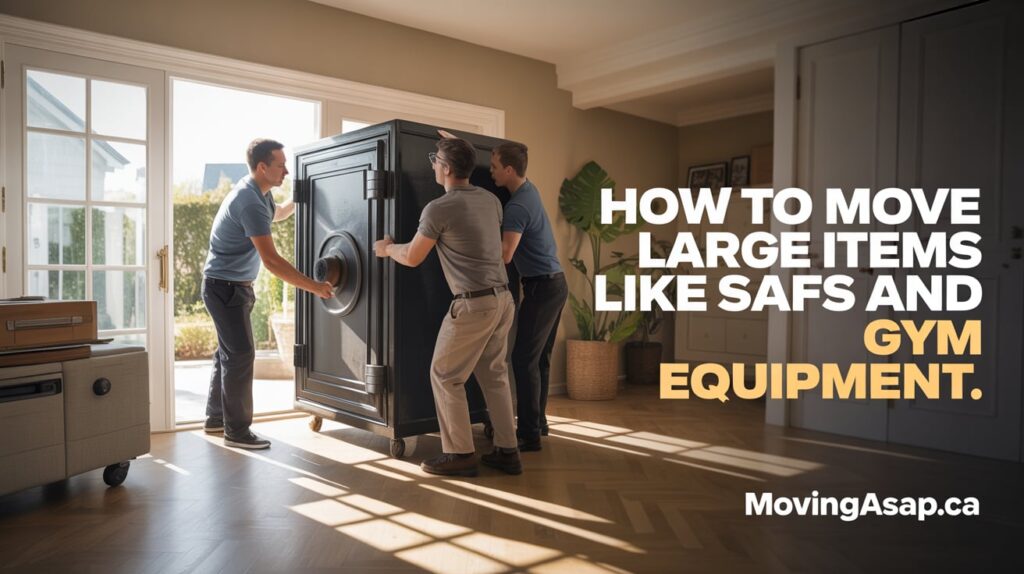Moving to a new place is already a demanding process, but when you need to move large items such as a safe, treadmill, or multi-station gym system, the challenge grows even bigger. These items are not only heavy but also awkwardly shaped, which means lifting, balancing, and transporting them requires more than just brute force. Without proper preparation and tools, you risk damaging your belongings, your property, or worse—injuring yourself.
In this comprehensive guide, we break down proven methods to move large, awkward items safely. You will learn the tools that make the job easier, tips professionals use, and whether hiring expert movers is worth the cost. By the end, you’ll know exactly how to approach moving heavy safes, bulky gym equipment, and other oversized belongings.

Why Moving Large Items is Different
Not all moves are created equal. Shifting boxes or a lightweight chair is completely different from handling a 700-pound safe or an elliptical machine that doesn’t fit through your doorway. Here’s why moving large items requires special attention:
- Weight distribution – Large items often have uneven weight balance, making them harder to carry.
- Size and shape – Gym equipment, for example, has protruding parts that can easily bump into walls or door frames.
- Risk of injury – Attempting to move a safe without the right technique can lead to back strain, muscle injuries, or even crushed fingers.
- Property damage – Scratched floors, dented walls, or broken staircases are common accidents during heavy moves.
Because of these challenges, planning and technique matter more than force.
Essential Preparation Before You Move Large Items
Before lifting anything, preparation is the key to a safe and efficient move. Here are steps professionals always follow:
1. Measure Entryways and Pathways
Check the dimensions of doors, hallways, and staircases. If an item is wider than the doorway, you may need to disassemble it or take off doors temporarily.
2. Clear the Route
Remove obstacles like rugs, lamps, or loose boxes. A clutter-free path reduces tripping hazards.
3. Protect Floors and Walls
Use moving blankets, cardboard sheets, or floor runners to shield your flooring and walls from damage.
4. Gather the Right Tools
You cannot move large items with your hands alone. Some essential tools include:
- Dollies (hand trucks, appliance dollies, furniture dollies)
- Moving straps and harnesses
- Furniture sliders
- Protective gloves
- Moving blankets and padding
5. Get Enough Help
Even with the best tools, moving oversized items requires extra hands. Recruit strong helpers or hire professional movers when needed.
How to Move a Safe
Safes are among the heaviest household items. Depending on size and material, they can weigh anywhere from 200 pounds to over 1,000 pounds. Here’s how to move one safely:
- Empty the Safe – Remove all valuables and shelves to lighten the weight.
- Wrap for Protection – Use moving blankets or bubble wrap to prevent scratches.
- Use a Heavy-Duty Dolly – Strap the safe securely onto an appliance dolly.
- Tilt with Care – Lean the safe slightly onto the dolly with the help of two or more people.
- Move Slowly – Push, don’t pull. Keep your back straight and lift with your legs.
- Navigating Stairs – For stair moves, always have extra support at the bottom and use stair climbing dollies if possible.
Pro Tip: Safes over 500 pounds should be moved by professional safe movers.
How to Move Gym Equipment
Home gyms are tricky because each piece of equipment is different. Some are foldable, while others must be partially disassembled.
Moving a Treadmill
- Unplug and Fold – If your treadmill folds, lock it in place.
- Secure the Belt – Tape the running belt to prevent movement.
- Use a Dolly – Tilt the treadmill onto a furniture dolly with straps.
- Two-Person Carry – Always have one person guiding from the front.
Moving an Elliptical
- Remove Handlebars and Pedals – This reduces bulk.
- Wrap Moving Blankets – Protect the frame.
- Carry Upright – Avoid laying ellipticals flat to protect electronics.
Moving a Multi-Station Gym
- Disassemble Parts – Remove weight stacks, pulleys, and seats if possible.
- Label Each Part – Keep bolts and screws in labeled bags.
- Transport in Sections – Move the frame separately from the weights.

Comparison: DIY vs Hiring Professionals
| Factor | DIY Moving | Professional Movers |
|---|---|---|
| Cost | Lower upfront cost | Higher upfront cost |
| Risk of Injury | High without experience | Low – movers are trained |
| Equipment Access | Limited to rented tools | Full access to moving tools |
| Time Required | Longer, requires planning | Faster and efficient |
| Safety of Property | Risk of damage | Insured and protected |
Conclusion: If you need to move large items like a safe or gym system, professionals offer a safer, faster solution.
Safety Tips to Keep in Mind
- Always lift with your legs, not your back.
- Use gloves for better grip and protection.
- Never rush. Take breaks when needed.
- Communicate clearly with helpers during each step.
- If in doubt, call professional movers.
Common Mistakes to Avoid
- Trying to move large items alone.
- Not measuring doorways or staircases beforehand.
- Forgetting to protect walls and floors.
- Using the wrong type of dolly or no straps.
- Ignoring safety gear like gloves or supportive shoes.
Real-Life Example
John had to move a 600-pound gun safe from his basement to the garage. He thought three friends and a regular dolly would be enough. Halfway up the stairs, the safe slipped, damaging the staircase railing and almost injuring one helper. Later, John hired professional movers, who used a stair-climbing dolly and moved the safe within 20 minutes.
The lesson: sometimes saving money is not worth the risk.
FAQ
Q1: Can I move a safe by myself?
No. Safes are too heavy and dangerous to move alone. At least two to three people and proper equipment are required.
Q2: What is the easiest way to move gym equipment?
Disassemble what you can, secure moving parts, and use dollies or sliders to transport heavy sections.
Q3: How do movers protect my home while moving large items?
Professionals use blankets, sliders, and padding to protect walls, floors, and furniture.
Q4: Is renting equipment cheaper than hiring movers?
Yes, but only if you already have enough manpower and confidence in moving. Otherwise, movers may be more cost-effective in the long run.
Q5: What should I do if my item does not fit through a doorway?
Check if the item can be disassembled. If not, remove the door temporarily or use alternate entry points.
Final Thoughts
The process of trying to move large items such as safes, treadmills, and gym equipment is not only about strength but also about planning, tools, and teamwork. By preparing the right way, using proper equipment, and knowing when to call professionals, you can make the process safer and less stressful. Whether you decide to do it yourself or hire experts, the goal is always the same: protect your belongings, your home, and your health.

